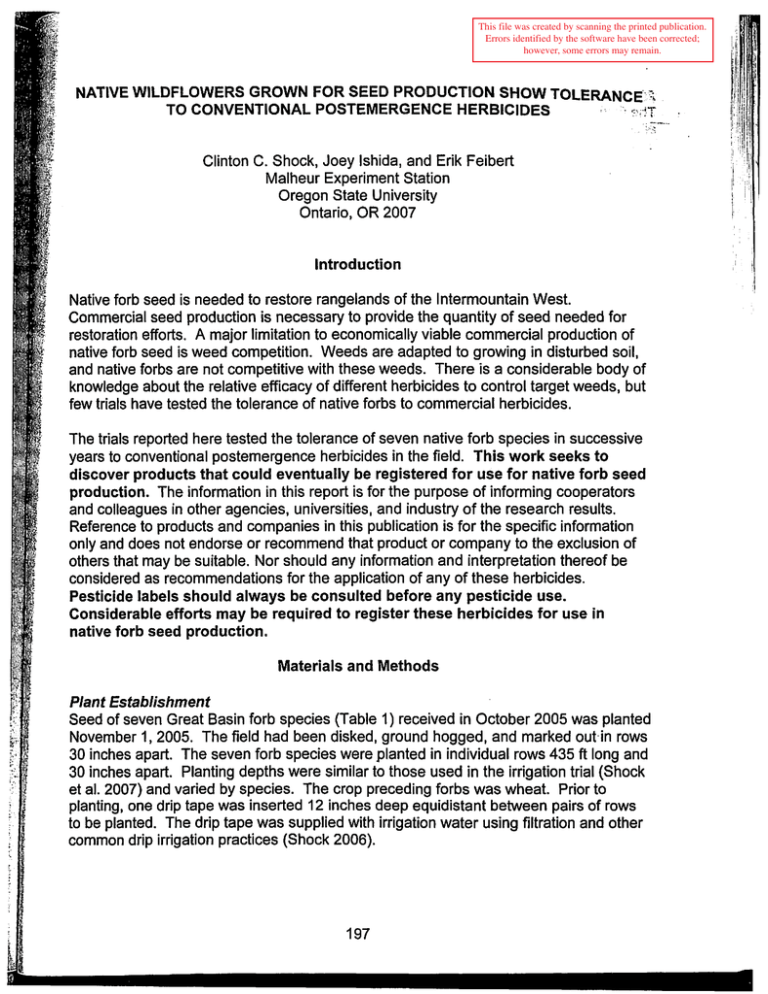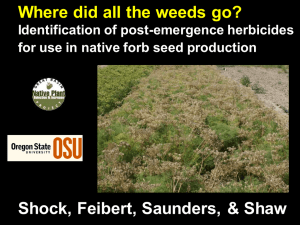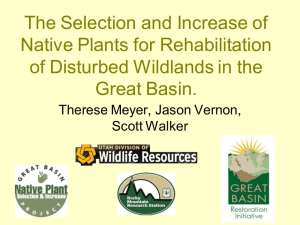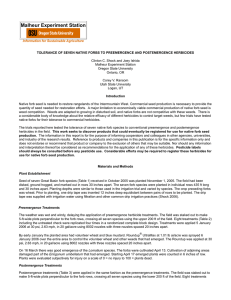Document 12118377
advertisement

This file was created by scanning the printed publication.
Errors identified by the software have been corrected;
however, some errors may remain.
NATIVE WILDFLOWERS GROWN FOR SEED PRODUCTION SHOW TOLERANCE--::~
TO CONVENTIONAL POSTEMERGENCE HERBICIDES- ~';-:T
Clinton C. Shock, Joey Ishida, and Erik Feibert
Malheur Experiment Station
Oregon State University
Ontario, OR 2007
Introduction
Native forb seed is needed to restore rangelands of the Intermountain West.
Commercial seed production is necessary to provide the quantity of seed needed for
restoration efforts. A major limitation to economically viable commercial production of
native forb seed is weed competition. Weeds are adapted to growing in disturbed soil,
and native forbs are not competitive with these weeds. There is a considerable body of
knowledge about the relative efficacy of different herbicides to control target weeds, but
few trials have tested the tolerance of native forbs to commercial herbicides.
The trials reported here tested the tolerance of seven native forb species in successive
years to conventional postemergence herbicides in the field. This work seeks to
discover products that could eventually be registered for use for native forb seed
production. The information in this report is for the purpose of informing cooperators
and colleagues in other agencies, universities, and industry of the research results.
Reference to products and companies in this publication is for the specific information
only and does not endorse or recommend that product or company to the exclusion of
others that may be suitable. Nor should any information and interpretation thereof be
considered as recommendations for the application of any of these herbicides.
Pesticide labels should always be consulted before any pesticide use.
Considerable efforts may be required to register these herbicides for use in
native forb seed production.
Materials and Methods
Plant Establishment
;
"
Seed of seven Great Basin forb species (Table 1) received in October 2005 was planted
November 1, 2005. The field had been disked, ground hogged, and marked out-in rows
30 inches apart. The seven forb species were planted in individual rows 435 ft long and
30 inches apart. Planting depths were similar to those used in the irrigation trial (Shock
et al. 2007) and varied by species. The crop preceding forbs was wheat. Prior to
planting, one drip tape was inserted 12 inches deep equidistant between pairs of rows
to be planted. The drip tape was supplied with irrigation water using filtration and other
common drip irrigation practices (Shock 2006).
197
'"
iii
i! '
2006 Postemergence Treatments
The field was staked out to make 5-ft-wide plots perpendicular to the forb rows, crossing
all seven species using the lower 200 ft of the field. Eight treatments including the
untreated check were replicated four times in a randomized complete block design (see
Tables 2-8). Treatments were applied May 24, 2006 at 30 psi, 2.63 mph, in 20 gal/acre
using 8002 nozzles with 3 nozzles spaced 20 inches apart. Plant injury in 2006 was
rated visually on May 31, June 15, and June 30.
In 2006 the trial was irrigated very little with the drip irrigation system because of ample
rainfall. Very few plants flowered and seed was not harvested in 2006.
Spring of 2007
By March 30, 2007 it was difficult if not impossible to distinguish any effects of the 2006
postemergence herbicide applications on any of the seven forb species. These
observations suggest that some degree of phytotoxic damage may be acceptable in
establishing native forb seed fields if effective weed control is achieved.
2007 Postemergence Treatments
The same treatments as 2006 were applied again to the same plots on April 24, 2007.
The same application specifications as in 2006 were used in 2007. Plant injury was
rated visually on May 1, May 11, May 25, and June 12.
Drip irrigations were applied every 2 weeks starting on April 5 and ending on June 24.
Each irrigation applied 2 inches of water.
Seed of Eriogonum umbel/atum, Penstemon acuminatus, P. deustus, and P. speciosus
was harvested by hand as the seed reached maturity. The seed was cleaned and
weighed. Lomatium dissectum, L. triternatum, and L. gray; did not flower in 2007.
General Considerations
The focus of the evaluations was forb tolerance of the herbicides, not weed control.
Therefore, weeds were removed as needed.
The effects of herbicides for each species on plant stand and injury were evaluated
independently from the effects on other species. Treatment differences were compared
using ANOVA and protected least significant differences at the 95 percent confidence
LSD (0.05) using NCSS Number Cruncher software (NCSS, Kaysville, UT).
198
,
"
I, '
I
Table 1. Forb species planted at the Malheur Experiment Station, Oregon State
University, Ontario, OR, and their origins.
Common name
Species
Origin
Shoofly Road (10)
Eriogonum umbel/a tum Sulfur buckwheat
Penstemon acuminatus Sand penstemon
Bliss Dam (10)
Penstemon deustus
Hotrock penstemon
Blacks Cr. Rd. (10)
Penstemon speciosus
Leslie Gulch (OR)
Royal or sagebrush penstemon
Fernleaf biscuitroot
Lomatium dissectum
Mann Creek (10)
Nineleaf desert parsley
Lomatium triternatum
Hwy 395 (OR)
Gray's lomatium
Lomatium grayi
Weiser R. Rd. (10)
,
,
Year
2004
2004
2003
2003
2003
2004
2004
i I
,
Results and Discussion
All observations made on the herbicides tested are strictly preliminary observations.
Herbicides that were observed to be damaging to the forbs as reported here might be
helpful if used at a lower rate or in a different environment. Herbicides that were
relatively safe for the forbs in these trials might be harmful if used at higher rates or in a
different environment. Nothing in this report should be construed as a recommendation.
Eriogonum umbellatum (Sulfur buckwheat)
Sulfur buckwheat showed herbicide injury on the May 1 evaluation with Goar® and
Caparol® as postemergence treatments (Table 2). There were no significant differences
in injury between herbicide treatments on the other evaluation dates. Select® and
Prowl® had among the lowest injury symptoms on the May 11, May 25, and June 12
evaluations.
There were no significant differences in seed yield between herbicide treatments (Table
2). Prowl, the untreated check, and Outlook® had among the highest seed yields with
no statistical differences between any of the treatments.
Table 2. Tolerance of Eriogonum umbel/a tum to postemergence herbicides applied on
April 24, 2007. At the time of herbicide applications, plants were 50 percent dormant.
Malheur Experiment Station, Oregon State University, Ontario, OR, 2007.
Treatment
Untreated
Buctril 2.0 EC
Goal2XC
Select 2.0 EC + Herbimax
Prowl H20 3.8 C
Caparol FL 4.0
Outlook 6.0 EC
Lorox 50 OF
LSD (0.05)
Rate
Ib ai/acre
0.125
0.125
0.094 + 1% v/v
1
0.8
0.656
0.5
Visual estimates of foliar injury, %
May 1 May 11
May 25
June 12
0.0
0.0
0.0
0.0
12.5
20.0
22.5
15.0
45.0
27.5
17.5
13.8
11.7
6.7
3.3
1.7
10.0
6.3
3.8
3.8
28.8
41.3
33.8
26.3
2.5
18.8
15.0
15.0
15.0
27.5
27.5
26.3
19.4
NS
NS
NS
199
Seed
yield
Ib/acre
91.7
38.1
42.6
57.6
115.0
27.3
75.1
35.6
NS
Penstemon acuminatus (Sand penstemon)
No injury symptoms were observed on the May 1 evaluation. On May 11, only Caparol
resulted in significantly higher injury symptoms than the check (Table 3). On May 25,
Caparol and Buctril® resulted in significantly higher injury symptoms than the check. On
June 12, Caparol, Buctril, and Select resulted in significantly higher injury symptoms
than the check.
Seed yields for Buctril, Select, Caparol, and Lorox® were significantly lower than the
untreated check (Table 3). Plots treated with Prowl, Outlook, and the untreated check
had among the highest seed yields.
Table 3. Tolerance of Penstemon acuminatus to postemergence herbicides applied on
April 24, 2007. At the time of herbicide applications, plants were beginning to flower.
Malheur Experiment Station, Oregon State University, Ontario, OR, 2007.
Treatment
Untreated
Buctril 2.0 EC
Goal2XC
Select 2.0 EC + Herbimax
Prowl H20 3.8 C
Caparol FL 4.0
Outlook 6.0 EC
Lorox 50 DF
LSD (0.05)
Rate
Ib ai/acre
0.125
0.125
0.094 + 1% v/v
1
0.8
0.656
0.5
Visual estimates of foliar inju~, %
May 1
May 11
June 12
May 25
0.0
0.0
0.0
0.0
0.0
0.0
0.0
0.0
0.0
0.0
0.0
NS
11.3
2.5
2.5
0.0
18.8
0.0
13.8
5.4
16.3
2.5
5.0
0.0
30.0
2.5
11.3
8.2
17.5
7.5
17.5
0.0
27.5
8.8
17.5
NS
Seed
yield
Ib/acre
520.4
305.7
417.8
304.6
509.4
162.9
502.6
264.9
183.4
Penstemon deustus (Hotrock penstemon)
On the first three evaluation dates, Buctril, Goal, Caparol, and Lorox resulted in
significantly higher injury symptoms than the check (Table 4). On the last evaluation
(June 12), plants treated with Caparol and Lorox still showed injury symptoms.
Seed yields for the Buctril, Goal, Caparol, and Lorox treatments were significantly lower .
than the untreated check (Table 4). Plots treated with Select, Outlook, Prowl, and the
untreated check had among the highest seed yields.
200
I.
!
,:'
1
:)1
I' .
Table 4. Tolerance of Penstemon deustus to postemergence herbicides applied on April
24,2007. At the time of herbicide applications, plants were growing vegetatively.
Malheur Experiment Station, Oregon State University, Ontario, OR, 2007.
Treatment
Untreated
Buctril 2.0 EC
Goal2XC
Select 2.0 EC + Herbimax
Prowl H20 3.8 C
Caparol FL 4.0
Outlook 6.0 EC
Lorox50 OF
LSD (0.05)
Rate
Ib ai/acre
0.125
0.125
0.094 + 1% v/v
1
0.8
0.656
0.5
Visual estimates of foliar injury, %
May 1
May 11
June 12
Ma:i 25
0.0
0.0
0.0
0.0
18.3
26.3
18.8
10.0
18.0
23.8
18.8
17.5
1.3
2.5
0.0
2.5
0.0
2.5
1.3
2.5
21.3
48.3
47.5
50.0
1.3
0.0
10.0
7.5
21.3
52.5
38.8
50.0
8.7
14.9
16.4
18.4
Seed
:iield
Ib/acre
903.1
348.5
333.0
927.3
747.6
86.8
835.1
108.5
334.8
Penstemon speciosus (Royal or sagebrush penstemon)
There were no significant injury symptoms for any of the treatments on the first
evaluation (Table 5). Only Caparol and Lorox treatments showed significant injury
symptoms, with Caparol having the most severe injury symptoms.
Seed yields for the Buctril, Goal, Caparol, and Lorox treatments were significantly lower
than the check (Table 5). Plots treated with Select, Outlook, Prowl, and the untreated
check had among the highest seed yields.
Table 5. Tolerance of Penstemon speciosus to postemergence herbicides applied on
April 24, 2007. At time of herbicide applications, plants were beginning to flower.
Malheur Ex~eriment Station, Oregon State Universit~, Ontario, OR, 2007.
Treatment
c'
1:;'
!.
"
~
.
Untreated
Buctril 2.0 EC
Goal2XC
Select 2.0 EC + Herbimax
Prowl H20 3.8 C
Caparol FL 4.0
Outlook 6.0 EC
Lorox 50 OF
LSD {0.10}
Rate
Ib ai/acre
0.125
0.125
0.094 + 1 % v/v
1
0.8
0.656
0.5
Visual estimates of foliar injury, %
Ma:t: 1 Ma~ 11 Ma:t:25 June 12
0.0
0.0
0.0
0.0
1.3
2.5
2.5
1.3
0.0
0.0
0.0
2.5
0.0
0.0
0.0
0.0
0.0
0.0
0.0
0.0
0.0
26.3
42.5
37.5
0.0
0.0
0.0
0.0
0.0
10.0
6.3
11.3
NS
4.2
4.1
6.2
Seed
:t:ield
Ib/acre
55.3
24.6
20.9
51.2
52.9
15.7
56.6
20.0
29.7
Lomatium dissectum (Fern leaf biscuitroot)
Only plants treated with Buctril showed significant injury symptoms on the first
evaluation (Table 6). There were no significant differences in injury between treatments
on the last three evaluations.
201
!'"I'
;I:
I
Lomatium dissectum had a very short growing period before going dormant and did not
flower in 2007.
Table 6. Tolerance of Lomatium dissectum to postemergence herbicides applied on
April 24, 2007. At the time of herbicide applications, plants were growing vegetatively.
Malheur Experiment Station, Ore'gon State University, Ontario, OR, 2007.
Treatment
Untreated
Buctril2.0 EC
Goal2XC
Select 2.0 EC + Herbimax
Prowl H20 3.8 C
Caparol FL 4.0
Outlook 6.0 EC
Lorox SO OF
LSD (0.05)
Rate
Ib ai/acre
Visual estimates of foliar injury, %
May 1 May 11 May 25 June 12
o
0
0
0
0.125
0.125
0.094 + 1% vlv
5
1.25
2.5
1.25
3.75
1.25
5
0
o
1
o
0
0
0
0
0
5
0.8
0.656
0.5
1.25
1.25
1.25
1.25
0
NS
3.75
1.25
1.25
NS
7.5
2.5
0
NS
o
2.2
Lomatium triternatum (Nineleaf desert parsley)
Only plants treated with Buctril showed injury symptoms (Table 7).
No seed was produced by Lomatium triternatum in 2007.
Table 7 . Tolerance of Lomatium triternatum to postemergence herbicides applied on
April 24, 2007. At the time of herbicide applications, plants were growing vegetatively.
Malheur Experiment Station, Oregon State University, Ontario, OR, 2007.
Treatment
Untreated
Buctril2.0 EC
Goal2XC
Select 2.0 EC + Herbimax
Prowl H20 3.8 C
Caparol FL 4.0
Outlook 6.0 EC
Lorox 50 OF
LSD (O.OS}
Rate
Ib ai/acre
0.125
0.125
0.094 + 1% v/v
1
0.8
0.656
O.S
Visual estimates of foliar injury, %
May 1 Ma~ 11 May 25 June 12
0
0
0
2.5
20
63.75
88.75
92.5
0
0
0
0
0
0
0
0
0
0
0
0
0
0
0
0
0
0
0
0
0
0
0
0
2.1
2.5
1.3
2.9
Lomatium grayi (Gray's lomatium)
On the May 1, May 25, and June 12 evaluations, only Buctril resulted in injury
symptoms significantly higher than the check (Table 8). On the May 11 evaluation,
Buctril and Caparol resulted in injury symptoms significantly higher than the check.
No seed was produced by Lomatium grayi in 2007.
202
\1
I
Table 8. Tolerance of Lomatium grayi to postemergence herbicides applied on April 24,
. 2007. At the time of herbicide applications, plants were growing vegetatively. Malheur
Experiment Station, Oregon State University, Ontario, OR, 2007.
Treatment
Untreated
Suctril 2.0 EC
Goal2XC
Select 2.0 EC + Herbimax
Prowl H20 3.8 C
Caparol FL 4.0
Outlook 6.0 EC
Lorox 50 OF
LSD (0.05)
Rate
Ib ai/acre
0.125
0.125
0.094 + 1% v/v
1
0.8
0.656
0.5
Injury %
Ma:t: 1 Ma:t: 11 Ma:t:25
0
0
0
15
37.5
41.25
2.5
6.25
1.25
0
0
0
0
0
0
2.5
11.25
7.5
0
0
0
0
0
0
2.7
8.8
8.8
June 12
0
28.75
3.75
0
0
6.25
0
0
6.7
Summary
All seven species tested were tolerant to Prowl and Outlook applied as postemergence
treatments at the rate, timing, and soils used in these trials. Penstemon deustus, P.
specious, and the Lomatium species were also tolerant to postemergence applications
of Select at the rate, timing, and soils used in these trials. Prowl and Outlook are broad
spectrum, soil-active herbicides that will prevent weed emergence during the season.
Select is a foliar-contact, grass herbicide. The use of these three herbicides may
provide the basis for an effective weed control program for seed production of these five
species. Further tests are warranted to describe the range of safety for these
herbicides and whether or not they have any undesirable interactions.
References
Shock, C.C. 2006. Drip irrigation: an introduction. Sustainable Agriculture Techniques,
Oregon State University Extension Service. EM8782-E Revised October 2006.
Shock, C.C., E.B.G. Feibert, L.D. Saunders, N. Shaw, and A. DeBolt. 2007. Seed
production of native forbs shows little response to irrigation in a wet year. Oregon State
University Agricultural Experiment Station Special Report 1075: 13-20.
203
I
,I
ii



